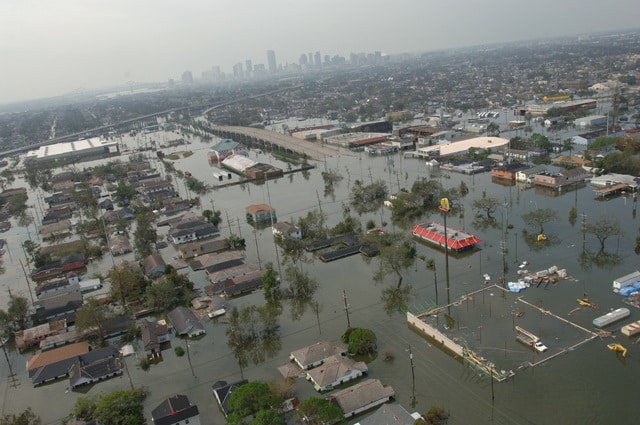Natural Disasters On The Rise
In recent years, climate variability and the increase in extreme events in the world, especially in the Caribbean, present a challenge for the region that many overlook. According to Brazil’s Natural Disaster Monitoring and Warning Center (CEMADEN), there is an increase in hurricanes in the Atlantic in 2021, being the third most active year since records have been kept.
The countries of the Caribbean region face new challenges in the construction of buildings in this new scenario: an increase in the number of hurricanes, extreme rainfall, higher average temperatures, forest fires, and floods. All this represents new challenges for engineering and construction companies working in the area.
According to a study conducted by MIT, there has been a historic increase in hurricane activity in the Caribbean over the past 150 years, unlike in other parts of the world.
All of this presents new challenges for engineering and construction companies working in the area.
Challenges In The Design Of Buildings Resistant To Natural Disasters
The economies of Caribbean countries such as the Dominican Republic, Trinidad and Tobago, Suriname and Guyana will experience significant growth in the coming years, especially the latter two, which have discovered significant oil reserves in their territories. This context will foreseeably require a greater demand for new and larger infrastructure for the development of the oil industry, which is expected to drive many other sectors in these countries.
These nations, like many others in the American continent, are exposed to different natural events, thus designing and constructing buildings that can withstand the effects of these phenomena is one of the fields in which most research is being carried out on construction systems and materials that are appropriate for these new challenges.
Many material manufacturing companies and engineering firms are researching how to provide safer and more secure building integrity and, therefore, greater safety and comfort for the building’s users.
There are currently initiatives focused on these challenges. An example of this is the Resilient Homes Challenge, a competition held by the World Bank together with Build Academy, Airbnb, and the Global Facility for Disaster Reduction and Recovery, which in 2019 encouraged the generation of ideas for disaster-resistant construction solutions at the scale of homes in the Caribbean. This had massive participation worldwide, highlighting the interest and importance of the topic.
Beyond Traditional Construction Solutions
It is common to think that in order to make something more resistant it is necessary to make it stronger, but the behavior of buildings in the face of this type of event, such as natural disasters, leads us to know that this is not necessarily the case in all cases. Experience and science tell us that flexible structures or those that allow absorbing and dissipating energy are more reliable technical solutions than rigid and heavy structures.
In the Caribbean countries, we are used to seeing constructions with traditional systems such as concrete structures and adobe brick or concrete block walls. Although these are solutions that over the years have demonstrated their good performance in the face of natural disasters, this is limited to the condition that they must be small dimension buildings, such as a house.
Challenges arise with larger buildings, especially those designed for industrial or commercial use, such as logistics warehouses, storage centers, factories, shopping malls, etc. Due to their dimensions, these types of buildings are not financially and technically viable if they use concrete and blocks, since they incur high costs at the time of their execution due to the inefficiencies inherent to the system.
Steel Structures Vs. Concrete Structures In The Event Of Natural Disasters
Designing a building that is resistant to hurricanes, but at the same time resistant to fire, earthquakes, and floods, and able to be built in a very short time and economically, represents the greatest challenge for the construction industry.
The use of metallic structures made of steel provides us with greater benefits to being able to construct larger buildings and smaller dimensions of their structural elements. This type of metallic structure has managed to evolve innovatively, optimizing resources, and reducing time and costs.
For many years, technicians and scientists have studied these natural phenomena, which allows the continuous updating and improvement of the technical building codes, which serve as the basis for the calculation of building structures.
Why Are Steel Structures An Option In The Face Of Natural Disasters?
It is very clear that building structures designed based on steel systems are a much more efficient alternative to those of the “traditional” type, based on concrete and blocks.
Part of this adequacy is due to the fact that the tools and advances in calculation software for dimensioning steel structures of buildings allow us to incorporate a series of variables, which in many cases are indicated as minimum values in international construction codes, guaranteeing safer buildings.
This takes into account conditions produced by extreme winds from hurricanes, resistance to seismic movements, time delays in the combustion of materials in the event of fire or slopes, and appropriate drainage to evacuate a greater amount of water from heavy rains.
Ensuring good building performance in the face of any natural disaster situation requires that steel structures be well-designed to withstand the loads and/or conditions required by natural disasters. Although they cannot be designed to be indestructible, the requirements of international design codes guarantee high standards of efficiency, quality, and safety.
In general, metal structures have a critical advantage over concrete structures in terms of their tolerance to deformation due to external loads, i.e., they are structures that perform better in the face of strong winds as they are more flexible and allow recovery to their original state.
It is unavoidable that behind the metallic structure there is a very good design that backs it up, but also good manufacturing and good execution on site. The structures must have the appropriate protections against corrosive agents and at the same time guarantee that their execution is carried out by professional teams following high-quality standards in the assembly.
Walls And Roofs With Insulated Panels Resistant To Natural Disasters
We have already talked about how metal structures perform better than traditional concrete building systems. But what about building envelopes? Those that are made block by block or brick by brick.
Combining the use of metal structures with concrete block walls is common in some countries, but we are not utilizing all the advantages and benefits that metal structures provide. Replacing those blocks or bricks with walls built with insulated panels is the most effective way to optimize construction processes and take advantage of all their benefits.
Insulated panels in facades and roofs will allow you to finish the enclosures in less time, have good efficiency in thermal resistance values, improve the dimensional stability and lightness of the building, have greater mechanical stability, good behavior against fire and there are finishes with a guarantee of many years against corrosion.
Let’s take a look at each of these advantages:
– Shorter execution time: insulated panels can be installed in large formats up to 1 m wide by 11.90 m long (3 ft x 39 ft). All this with very little labor and with the help of a small crane to cover large areas in no time.
– Thermal resistance: being a system composed of two steel sheets on the outside and a central core of polyurethane or rock wool, it serves as a barrier against heat transmission. That is, it protects the interior of the building from temperature rise or serves as a barrier to prevent cooling loss from the interior.
– Dimensional stability: This is the property of some materials that when subjected to changes in temperature and humidity do not lose their shape and maintain their original dimensions. This is important mainly in countries with high temperatures during the summer.
– Lightness of the building: The load values (weight of the building) to be supported by the foundations are lower, which allows a reduction in the dimensioning of the foundations, and consequently a cost reduction.
– Mechanical stability: Refers to the property of the insulated panel building to maintain its original shape despite being subjected to forces or actions due to wind conditions or seismic movements.
– Remarkable fire performance: The development of polyurethane products with enhanced fire performance, such as insulated panel cores made of polyisocyanurate or those made of rock wool, guarantees good fire resistance.
– Corrosion-resistant finishes: Manufacturers of insulating panels have developed special finishes with an excellent performance against corrosive environmental agents. There are different levels of protection for the panels from the simplest as a polyester paint to high-performance paints in HPS200, HDX Granite, or Prisma.
For these reasons, the cladding of both walls and roofs of buildings with insulated panels is an excellent alternative in combination with steel structures for buildings in areas frequently affected by natural disasters.
Conclusions On Natural Disasters And Steel Buildings
While it is true that climate change results in some geographical areas being hit more frequently by natural disasters, these areas are experiencing a growth in their economies that demands the construction of larger, more complex, more efficient, and safer buildings in the face of the new climatic conditions.
We are seeing how engineering and construction companies, as well as materials manufacturers, are looking for more efficient construction solutions to replace the traditional ways of building in these countries, adapting to much more demanding construction codes and doing so in less time and at lower costs.
There are many open fronts of research on new efficient construction systems in the face of these natural disasters, however, currently, metal structures are gaining ground over traditional concrete structures and insulated panels in roofs and ceilings stand out as the most efficient products and systems for constructing these buildings in the face of these environmental demands.

